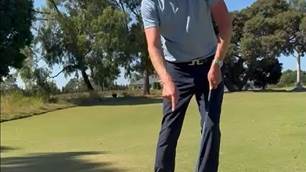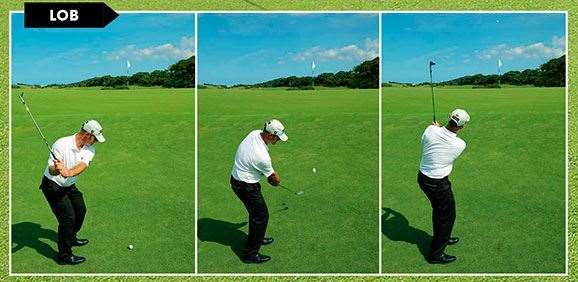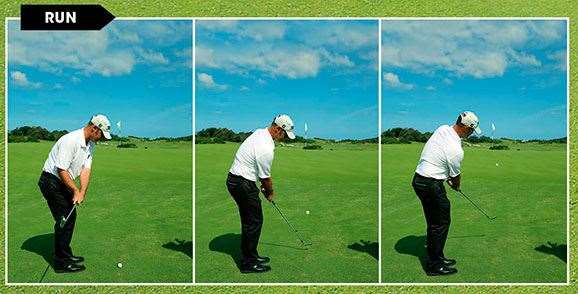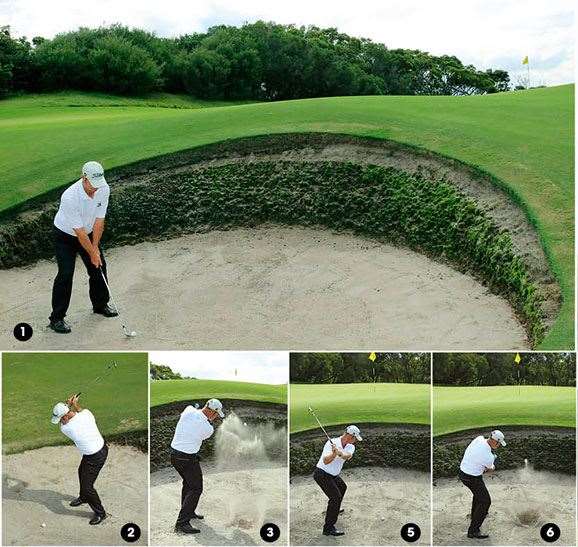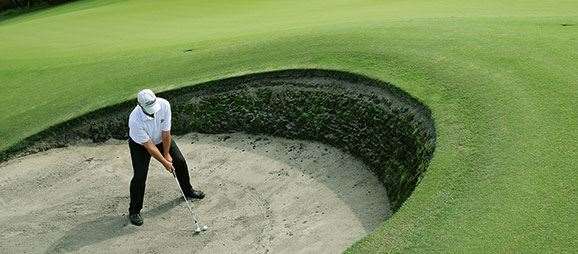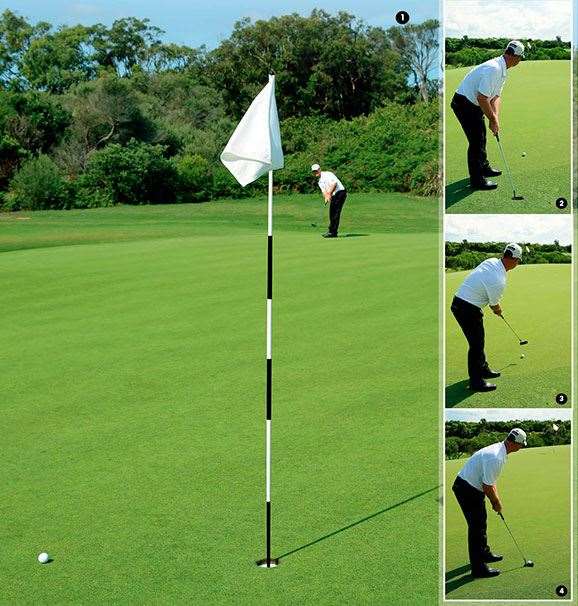Being able to successfully get up and down from a variety of lies around the green slash your scores. Here are five shot scenarios you can easily convert taking three shots to find the hole in two.
Being able to successfully get up and down from a variety of lies within 50 metres of the green will quickly slash your scores. Here are five shot scenarios where you can easily convert taking three shots to find the hole in two.
THE SPINNING PITCH FROM 50 METRES
You have laid up short on a par-5 or driven to within close pitching distance on a par-4 and you have a great opportunity to make a birdie with a good pitch.
As is the case here, you have plenty of green between you and the flag so you can fly your pitch most of the way to the hole.
Set-up with the ball back in your stance a little to ensure you make contact with the ball before the ground. This will also make the ball fly a little lower with greater spin.
Perhaps the most important aspect of the 50-metre pitch is to be deliberate with the length of your backswing, making sure it is a shorter (pics 1 & 2), and then accelerate through the shot (pics 3 & 4). If your backswing is too long you will almost certainly decelerate with your downswing and mis-hit the shot. Giving the shot positive acceleration through impact helps the ball skip up the green and then spin to a halt. Ideally, the ball will fly 90 percent of the way to the hole, bounce once and then bite on the second bounce … leaving you a close putt to convert the up-and-down.
WHEN TO RUN, WHEN TO LOB
Knowing when to lob a pitch shot or play a pitch/chip-and-run shot, is a key element of improving your short game and, ultimately, shooting lower scores.
Playing the right shot at the right time – particularly knowing the shot that will offer the best outcome with the biggest margin for error – is a sure shot-saver for any golfer.
As a general rule, the time to lob a pitch is when the ball is going to land on flat ground or into an upslope. You take a lot of risk by trying to hit a delicate lob shot onto a downslope and the ball is probably going to run a long way beyond the hole. Therefore, it is best to take a chip-and-run option when faced with a downslope to the flag.
Obviously you need to assess each shot situation on its merits, but if you use the above rule as a guide it will help you make the right shot choice.
The other thing to consider is the lie. If your ball is sitting on a tight lie around the green, hitting a lob shot is a high-risk option and you know in the back of your mind even your best effort is not going to finish particularly close to the hole. If it is at all possible to play a chip-and-run in this situation do it, as the last thing you want to do is blade a wedge way through the green trying to hit such a precise lob shot.
LONG, DEEP BUNKER SHOT
A long shot to a flag from a deep bunker is enough to scare the wits out of most club golfers but it doesn’t have to be so daunting.
Here, I’ve got 20 metres to go to the flag (pic 1) and I can only really see the top of the flag from down in the trap. The most important thing here firstly is to get the ball out, so I suggest you use a 56° sand wedge or, if the lip is not so high, a 53° gap wedge.
As this is a long shot, I’m going to need to take a big swing to get the distance. This big swing is also going to help me get a bit more height. Position the ball forward of middle in your stance. Unlike a short bunker shot, I suggest you narrow your stance a little and incorporate a little bit of hip turn on the backswing (pic 2). This turn, like a shot from the fairway, will create enough energy to ensure the ball comes out high (pic 3) and carries further towards the flag.
SHORT, DEEP BUNKER SHOT
The short shot from a deep bunker, like the long shot, still requires a big swing because you need height.
But, due to the short length of the shot (pic 4), we need to take some energy away from the shot so the ball doesn’t fly too far. To do that, widen your stance and during the swing make your body more passive, which means there is little or no turn on the backswing (pic 5). In fact, this is a slow arms-and-wrist swing, which then accelerates through the ball (pic 6).
Finally, set the clubface a little more open than you would for a longer shot and position the ball forward in your stance so the club, at address, is almost leaning away from the target, i.e. the grip is slightly further from the target than the clubhead.
Depending on how soft the sand is, you can use a 56° sand wedge or a 60° lob wedge.
BETTER LAG PUTTING
One reason why a lot of people three-putt is they not only leave their first putt too far from the hole, but they also leave it in a spot where the second putt is quite difficult.
When you are lining up your first putt, try to identify an area around the hole where hitting your next putt is going to be relatively easy.
For example, here I’m faced with a 45-foot putt, downhill with about six feet of break from left to right. I’ve probably got five chances in a hundred of holing the putt so I am going to have to hit a second putt. Now, if I imagine there is a big circle around the hole, I picture it divided into quadrants. For this particular putt I have identified that if I hit my first putt to finish right of the hole, it will leave me with a reasonably straight uphill second putt, which I am comfortable in hitting (pic 1). However, if I aim too far left and don’t hit the first putt strong enough, I’ll be left with a tricky left-to-right downhill putt. So identifying your ‘best miss’ might mean a second putt from six feet that you are comfortable with, against a tricky putt from three feet.
Make this assessment while you take some practice strokes for your first putt, as you look at the hole from behind the ball (pics 2 & 3). Looking at the hole will give you a sense of the distance you face and the length of stroke you will require to get the ball to the hole … or rolling into your chosen quadrant. Then, it’s just a matter of pulling the trigger (pic 4).
Related Articles

Video Lesson: Hear the swoosh past the ball

Playing From The Tips Ep.106: Texas Open, LIV Miami & LPGA Match Play
